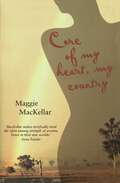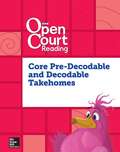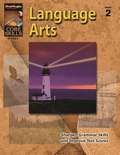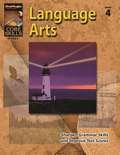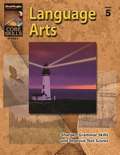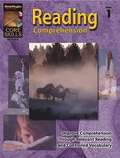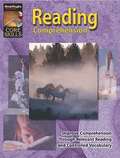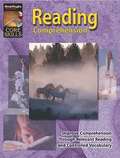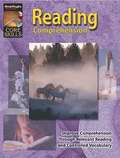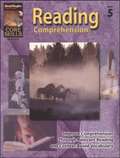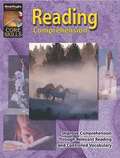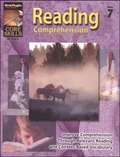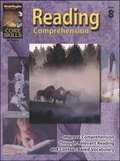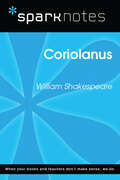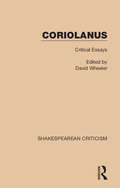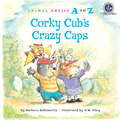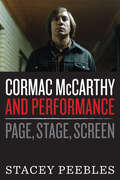- Table View
- List View
Core Knowledge Language Arts, Grade 1, Domain 7: The History of the Earth, Tell It Again!™ Flip Book
by Core Knowledge Foundation Amplify Inc.NIMAC-sourced textbook
Core Knowledge Language Arts, Grade 1, Domain 9: Fairy Tales, Tell It Again!™ Flip Book
by Core Knowledge Foundation Amplify Inc.NIMAC-sourced textbook
Core Knowledge Language Arts, Grade 2, Unit 3, Workbook
by Core Knowledge Foundation Amplify Inc.NIMAC-sourced textbook
Core Knowledge Language Arts, Grade 2, Unit 4, Workbook
by Core Knowledge Foundation Amplify Inc.NIMAC-sourced textbook
Core Knowledge Language Arts, Grade 2, Unit 6 Reader: The War of 1812
by Core Knowledge Foundation Amplify Inc.NIMAC-sourced textbook
Core Of My Heart, My Country
by Maggie MacKellarWhen Georgiana Molloy gave birth on the beach at Augusta in 1830 with boxes of her possessions lying where they'd landed, she was one of the many women who literally had to remake their homes out of the broken bones of their past. In this passionate book Maggie MacKellar tells the stories of women on the frontier in Canada and Australia who ventured out in bonnets and petticoats to collect seeds, who abandoned sidesaddles to ride in the mountains, who risked their reputations to climb mountains—and beyond this it tells of the risky business of women who put their lives on the page to claim the importance of their experience. Core of My Heart, My Country weaves together experience and insight from women who lived and wrote in different landscapes, in different climates and in different eras. It is a provocative and remarkable encounter with buried stories and persistent myths.
Core Predecodable And Decodable 4-color Takehome, Grade K: Open Court Reading (Imagine It)
by McGraw-Hill Education StaffEach story supports instruction in new phonics elements and incorporates elements and high frequency words that have been previously taught.
Core Skills: Language Arts, Grade 2
by Steck-VaughnLanguage Arts was developed to help your child improve the language skills he or she needs to succeed. The book emphasizes skills in the key areas of grammar, punctuation, vocabulary, writing, and research. The lessons included in the book provide many opportunities for your child to practice and apply important language and writing skills. These skills will help your child excel in all academic areas, increase his or her scores on standardized tests, and have a greater opportunity for success in his or her career.
Core Skills: Language Arts, Grade 4
by Steck-VaughnLanguage Arts was developed to help your child improve the language skills he or she needs to succeed. The book emphasizes skills in the key areas of grammar, punctuation, vocabulary, writing, and research. The more than 100 lessons included in the book provide many opportunities for your child to practice and apply important language and writing skills. These skills will help your child excel in all academic areas, increase his or her scores on standardized tests, and have a greater opportunity for success in his or her career.
Core Skills: Language Arts, Grade 5
by Steck-VaughnLanguage Arts was developed to help your child improve the language skills he or she needs to succeed. The book emphasizes skills in the key areas of grammar, punctuation, vocabulary, writing, and research. The more than 100 lessons included in the book provide many opportunities for your child to practice and apply important language and writing skills. These skills will help your child excel in all academic areas, increase his or her scores on standardized tests, and have a greater opportunity for success in his or her career.
Core Skills: Language Arts, Grade 6
by Steck-VaughnLanguage Arts was developed to help your child improve the language skills he or she needs to succeed. The book emphasizes skills in the key areas of grammar, punctuation, vocabulary, writing, and research. The more than 100 lessons included in the book provide many opportunities for your child to practice and apply important language and writing skills. These skills will help your child excel in all academic areas, increase his or her scores on standardized tests, and have a greater opportunity for success in his or her career.
Core Skills: Language Arts, Grade 7
by Steck-VaughnLanguage Arts was developed to help your child improve the language skills he or she needs to succeed. The book emphasizes skills in the key areas of grammar, punctuation, vocabulary, writing, and research. The more than 100 lessons included in the book provide many opportunities for your child to practice and apply important language and writing skills. These skills will help your child excel in all academic areas, increase his or her scores on standardized tests, and have a greater opportunity for success in his or her career.
Core Skills: Language Arts, Grade 8
by Steck-VaughnThe book emphasizes skills in the key areas of grammar, punctuation, vocabulary, writing, and research.
Core Skills: Reading Comprehension, Grade 1
by Steck-VaughnWelcome to the Steck-Vaughn Core Skills: Reading Comprehension series! You have selected a unique book that focuses on developing your child's comprehension skills, the reading and thinking processes associated with the printed word. Because this series was designed by experienced reading professionals, your child will have reading success as well as gain a firm understanding of the necessary skills outlined in national standards. The stories are comprised of words carefully chosen from the Doich Basic Sight Vocabulary and the Kucera-Francis word list. Words that appear most frequently in primary reading basal series were also used. For stories 1--16 (Part One), this vocabulary list includes every word used in the stories. For stories 17-34 (Part Two), this vocabulary list includes the words that are introduced as new vocabulary and defined.
Core Skills: Reading Comprehension, Grade 2
by Steck-VaughnWelcome to the Steck-Vaughn Core Skills: Reading Comprehension series! You have selected a unique book that focuses on developing your child's comprehension skills, the reading and thinking processes associated with the printed word.
Core Skills: Reading Comprehension, Grade 3
by Steck-VaughnWelcome to the Steck-Vaughn Core Skills: Reading Comprehension series! You have selected a unique book that focuses on developing your child's comprehension skills, the reading and thinking processes associated with the printed word. The stories are comprised of words carefully chosen from the Dolch Basic Sight Vocabulary and the Kucera-Francis word list. Words that appear most frequently in primary reading basal series were also used. This vocabulary list does not include every word students are expected to read in the stories, but rather is a list of words that are introduced as new vocabulary and defined.
Core Skills: Reading Comprehension, Grade 4
by Steck-VaughnWelcome to the Steck-Vaughn Core Skills: Reading Comprehension series! You have selected a unique book that focuses on developing your child's comprehension skills, the reading and thinking processes associated with the printed word.
Core Skills: Reading Comprehension, Grade 5
by Steck-VaughnWelcome to the Steck-Vaughn Core Skills: Reading Comprehension series! You have selected a unique book that focuses on developing your child's comprehension skills, the reading and thinking processes associated with the printed word.
Core Skills: Reading Comprehension, Grade 6
by Steck-VaughnWelcome to the Steck-Vaughn Core Skills: Reading Comprehension series! You have selected a unique book that focuses on developing your child's comprehension skills, the reading and thinking processes associated with the printed word.
Core Skills: Reading Comprehension, Grade 7
by Steck-VaughnWelcome to the Steck-Vaughn Core Skills: Reading Comprehension series! You have selected a unique book that focuses on developing your child's comprehension skills, the reading and thinking processes associated with the printed word.
Core Skills: Reading Comprehension, Grade 8
by Steck-VaughnWelcome to the Steck-Vaughn Core Skills: Reading Comprehension series! You have selected a unique book that focuses on developing your child's comprehension skills, the reading and thinking processes associated with the printed word.
Coriolanus (SparkNotes Literature Guide Series)
by SparkNotesCoriolanus (SparkNotes Literature Guide) by William Shakespeare Making the reading experience fun! Created by Harvard students for students everywhere, SparkNotes is a new breed of study guide: smarter, better, faster.Geared to what today's students need to know, SparkNotes provides:chapter-by-chapter analysis explanations of key themes, motifs, and symbols a review quiz and essay topics Lively and accessible, these guides are perfect for late-night studying and writing papers.
Coriolanus: Critical Essays (Shakespearean Criticism)
by David WheelerOriginally published in 1995. Providing the most influential historical criticism, but also some contemporary pieces written for the volume, this collection includes the most essential study and reviews of this tragic play. The first part contains critical articles arranged chronologically while the second part presents reviews of stage performances from 1901 to 1988 from a variety of sources. Chapters chosen are representative of their given age and critical approach and therefore show the changing responses and the topics that interested critics in the play through the years. Coriolanus is an unsympathetic character and the play has been traditionally less popular than other tragedies - a comprehensive introduction by the editor discusses these attitudes to the play and the reasons behind them.
Corky Cub's Crazy Caps (Animal Antics A to Z)
by Barbara deRubertisGet to know Alpha Betty&’s class in the award-winning, 26-book alphabet series ANIMAL ANTICS A TO Z! From Alexander Anteater to Zachary Zebra, it&’s one adventure after another. Zip along with these zany characters as they find new friends, test their talents, and have a rip-roaring good time! Corky Cub's best chum is moving away! Who will play catch with him? Who will make cookies and crazy caps with him? Can Corky's classmates at Alpha Betty's school help solve his problem? This series is a perfect read-aloud choice to help kids discover the joy of letter sounds and give them the phonics building blocks they need for reading success. With delightful illustrations by Paddington Bear illustrator R.W. Alley, ANIMAL ANTICS A TO Z is an excellent resource for parents and educators alike. Activities in each book plus free activities online add to the fun. Winner: Teachers&’ Choice Award for Children&’s BooksWinner: Teachers&’ Choice Award for the Family
Cormac McCarthy and Performance: Page, Stage, Screen
by Stacey PeeblesCormac McCarthy is renowned as the author of popular and acclaimed novels such as Blood Meridian, All the Pretty Horses, and The Road. Throughout his career, however, McCarthy has also invested deeply in writing for film and theater, an engagement with other forms of storytelling that is often overlooked. He is the author of five screenplays and two plays, and he has been significantly involved with three of the seven film adaptations of his work. In this book, Stacey Peebles offers the first extensive overview of this relatively unknown aspect of McCarthy&’s writing life, including the ways in which other artists have interpreted his work for the stage and screen. Drawing on many primary sources in McCarthy&’s recently opened archive, as well as interviews, Peebles covers the 1977 televised film The Gardener&’s Son; McCarthy&’s unpublished screenplays from the 1980s that became the foundation for his Border Trilogy novels and No Country for Old Men; various successful and unsuccessful productions of his two plays; and all seven film adaptations of his work, including John Hillcoat&’s The Road (2009) and the Coen brothers&’ Oscar-winning No Country for Old Men (2007). Emerging from this narrative is the central importance of tragedy—the rich and varied portrayals of violence and suffering and the human responses to them—in all of McCarthy&’s work, but especially his writing for theater and film.

